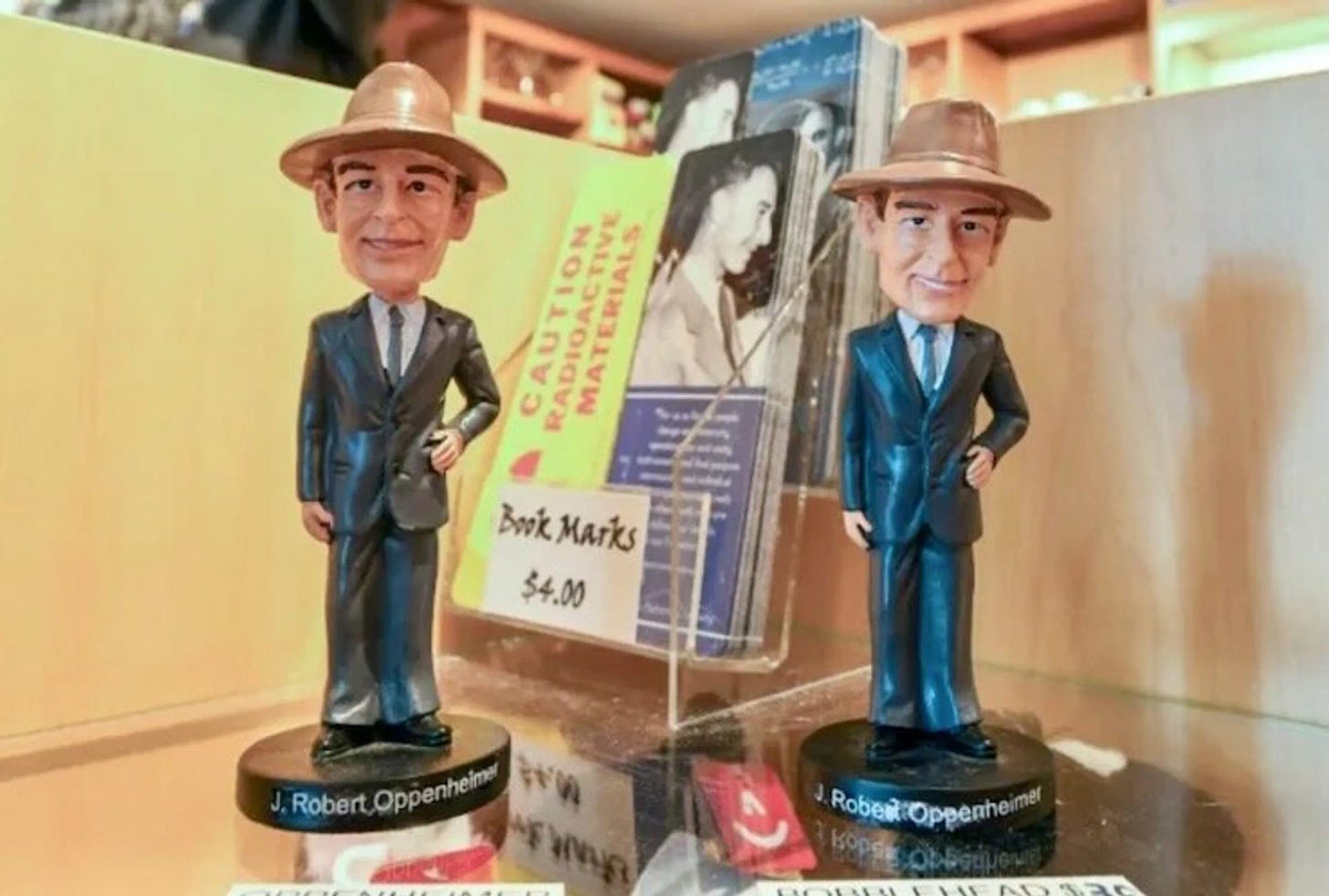Greg Mitchell is the author of a dozen books, including “Hiroshima in America,” “Atomic Cover-up,” and the recent award-winning “The Beginning or the End: How Hollywood—and America—Learned to Stop Worrying and Love the Bomb.” He has directed three documentary films since 2021, including two for PBS (plus award-winning “Atomic Cover-up”). He has written widely about the atomic bomb and atomic bombings, and their aftermath, for over forty years. “ You can still subscribe to this newsletter for free.
Yes, that’s an Oppie bobblehead on sale at a Los Alamos tourist shop—well, his views on the use of his bomb against two cites was notably shaky—in a photo that ran with new story below from Agence France-Presse:
With its billion dollars in revenue, the film Oppenheimer not only lined the pockets of Hollywood studios: it also caused a small tourist boom in the mysterious town of Los Alamos.
Directed by Christopher Nolan, ultra-favorite for the Oscar for best film and nominated in 12 other categories, the feature film traces the life of the father of the atomic bomb. Much of the action takes place in Los Alamos, a hastily built town in New Mexico to house a top secret laboratory, the idea of Robert Oppenheimer.
Since the film’s release last July, tourists have become interested in sites such as the Oppenheimer House and the Fuller Lodge, where nuclear scientists held parties to celebrate their success in making the bomb. It’s also harder to get a dinner reservation in town.
Visitor numbers jumped 68 percent last year, according to city officials. “We started seeing a huge influx last spring, before the film even hit theaters,” says local historical society guide Kathy Anderson, who had to triple her number of daily tours. “If the film wins the Oscars, I think the interest will be even greater.”
But this success masks the complicated relationship of Los Alamos to its past and to the scientist, still affectionately nicknamed “Oppie” by some.
The boom in tourism could help raise the $2 million needed to restore the century-old house where the Oppenheimers lived. A tired building in dire need of repairs. “Oppenheimer was known for his Martinis and for being a very welcoming host. Many historical events took place in these rooms,” says Nic Lewis, historian at Los Alamos National Laboratory.
Meanwhile, as the Oscars countdown begins (with little suspense, unlike the Trinity test), Oppenheimer and Los Alamos—and Hiroshima survivors—will be featured early in a new 11-part doc series, “Turning Point: The Bomb and the Cold War,” coming to Netflix on March 11. Here is the trailer (spot my old friend Dan Ellsberg) and their promo:
From Luminant Media and director Brian Knappenberger comes the definitive documentary series on the Cold War. Beginning with the development of the atomic bomb and the dramatic proliferation of nuclear weapons in the decades after, the series traces Cold War history past the collapse of the Soviet Union to the rise of Vladimir Putin and into the Russian invasion of Ukraine.
“Turning Point: The Bomb and the Cold War” features more than 100 interviews conducted in 7 countries around the world revealing deeply personal stories that show how much the Cold War transformed lives and drove world history. From survivors of the atomic bomb dropped on Hiroshima to extensive filming in Ukraine, Germany, and some of the former Soviet Republics, the series includes interviews with seven current or former world leaders including Ukrainian President Volodymyr Zelenskyy as well as prominent political figures like NATO Secretary General Jens Stoltenberg, former CIA Director Robert Gates and former Secretary of State Condoleezza Rice. The series also features key figures of the Cold War, including the son of Julius and Ethel Rosenberg, prominent German protest leaders who helped topple the Berlin Wall, as well as one of the last long form interviews with nuclear activist Daniel Ellsberg, who called the United States classified nuclear plans “institutional insanity.”
This nine-part docuseries is an exploration of the decades-long conflict between the United States and the Soviet Union framed by current events that make it clear we are still very much feeling the effects of the Cold War.
Finally, I was not aware until yesterday when I came across a new piece, that the popular and Oscar-nominated “The Wind Rises” animated film from 2013 directed by the celebrated Hayao Miyazaki mirrored in a way Oppenheimer moral conflicts. It centered on a boy, based on an historical character, who dreamed of flight and then grew up to create the most famous, deadly and brilliantly executed, Japanese fighter plane, the “Zero.” Of course, when that plane was used so widely and successfully in World War 2, the creator felt kinda bad. Still, the film is sentimental and more of a love story, which caused some protests in Asia, but American critics and others loved it.
Miyazaki is up for another Oscar next week, for “The Boy and the Heron,” his first film since “The Wind Rises.” He has been a firm foe of modern day Japanese moves to militarism and also refused to attend the Oscars ceremony in 2003 protesting America’s bombing of Iraq. We’ll see if he boycotts the ceremony next week due to U.S. funding of Israel’s bombing of Gaza. Read more here about “The Wind Rises.” A trailer:





Greg, I'm not sure if you've seen this film, but we're screening it opening night in this year's Salem Film Fest:
https://vimeo.com/914819717/bf5b4d27bf
Stan